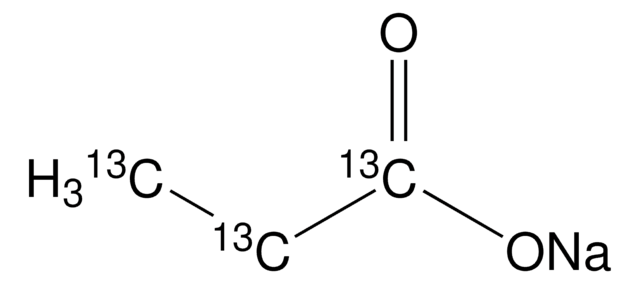488380
Sodium butyrate-13C4
99 atom % 13C
Sinónimos:
Butyric acid-13C4 sodium salt
Iniciar sesiónpara Ver la Fijación de precios por contrato y de la organización
About This Item
Fórmula lineal:
13CH3(13CH2)213CO2Na
Número de CAS:
Peso molecular:
114.06
Número MDL:
Código UNSPSC:
12352106
ID de la sustancia en PubChem:
NACRES:
NA.12
Productos recomendados
pureza isotópica
99 atom % 13C
Formulario
solid
mp
250-253 °C (lit.)
cambio de masa
M+4
cadena SMILES
[Na+].[13CH3][13CH2][13CH2][13C]([O-])=O
InChI
1S/C4H8O2.Na/c1-2-3-4(5)6;/h2-3H2,1H3,(H,5,6);/q;+1/p-1/i1+1,2+1,3+1,4+1;
Clave InChI
MFBOGIVSZKQAPD-UJNKEPEOSA-M
Envase
This product may be available from bulk stock and can be packaged on demand. For information on pricing, availability and packaging, please contact Stable Isotopes Customer Service.
Palabra de señalización
Warning
Frases de peligro
Consejos de prudencia
Clasificaciones de peligro
Acute Tox. 4 Oral - Eye Irrit. 2 - Skin Irrit. 2
Código de clase de almacenamiento
11 - Combustible Solids
Clase de riesgo para el agua (WGK)
WGK 1
Punto de inflamabilidad (°F)
Not applicable
Punto de inflamabilidad (°C)
Not applicable
Elija entre una de las versiones más recientes:
¿Ya tiene este producto?
Encuentre la documentación para los productos que ha comprado recientemente en la Biblioteca de documentos.
Los clientes también vieron
Annabell Bachem et al.
Immunity, 51(2), 285-297 (2019-07-06)
Interactions with the microbiota influence many aspects of immunity, including immune cell development, differentiation, and function. Here, we examined the impact of the microbiota on CD8+ T cell memory. Antigen-activated CD8+ T cells transferred into germ-free mice failed to transition into long-lived
Petia Kovatcheva-Datchary et al.
Cell reports, 26(13), 3772-3783 (2019-03-28)
The gut microbiota can modulate human metabolism through interactions with macronutrients. However, microbiota-diet-host interactions are difficult to study because bacteria interact in complex food webs in concert with the host, and many of the bacteria are not yet characterized. To
Dan Vershkov et al.
Cell reports, 26(10), 2531-2539 (2019-03-07)
Fragile X syndrome (FXS) is caused primarily by a CGG repeat expansion in the FMR1 gene that triggers its transcriptional silencing. In order to investigate the regulatory layers involved in FMR1 inactivation, we tested a collection of chromatin modulators for
Nuestro equipo de científicos tiene experiencia en todas las áreas de investigación: Ciencias de la vida, Ciencia de los materiales, Síntesis química, Cromatografía, Analítica y muchas otras.
Póngase en contacto con el Servicio técnico










